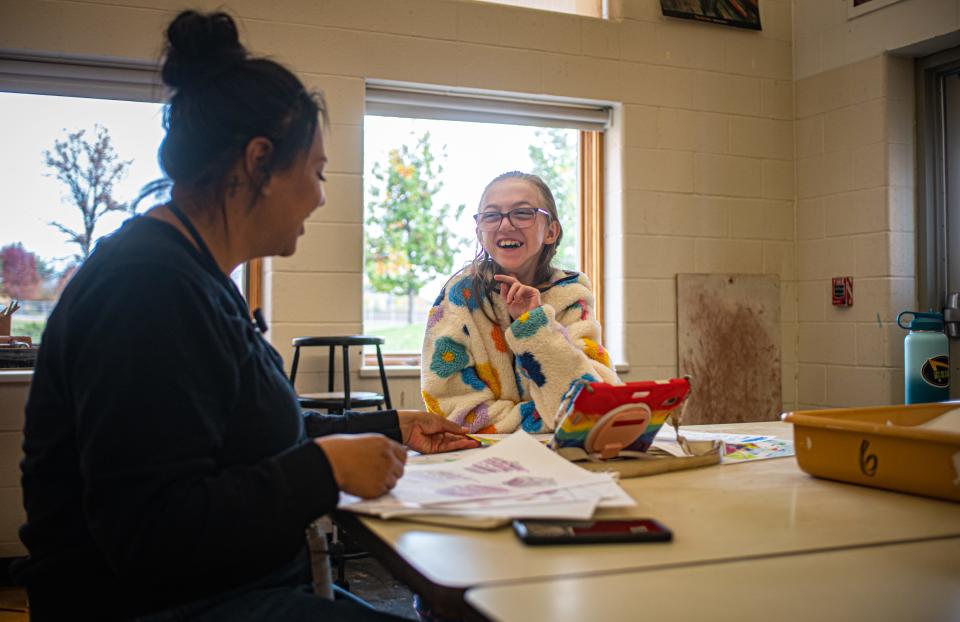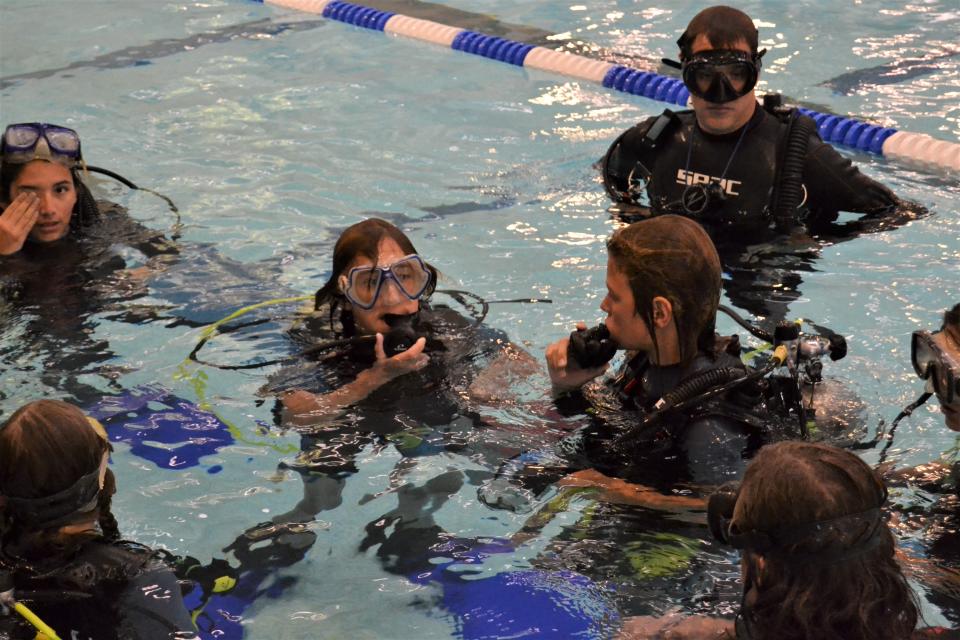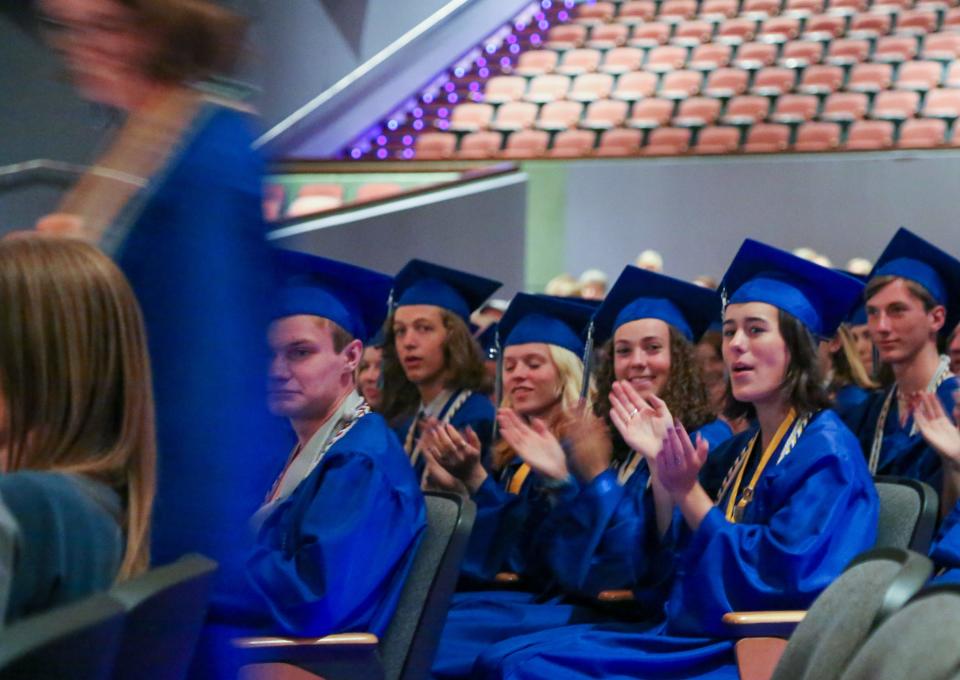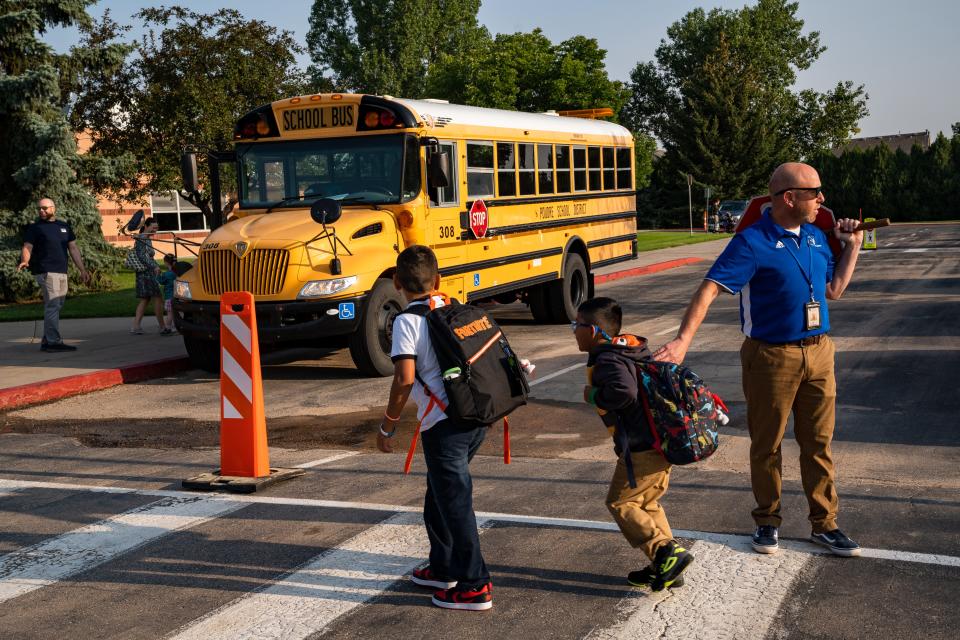School choice: What you need to know about options within Poudre School District
With growing concerns about the consolidation or closure of some schools due to declining enrollment and budget cuts, there’s more attention than ever on the various educational options provided by Poudre School District.
Those options are extensive, ranging from Core Knowledge and International Baccalaureate programs at several schools to more niche offerings like bilingual education, expeditionary learning, project-based learning, Leader in Me and STEM/STEAM programs that use a multidisciplinary approach to emphasize science, technology, engineering and mathematics, with some also including the arts.
A recent school consolidation plan threatened the continuation of some of those models even as Superintendent Brian Kingsley insisted the goal was to continue “offering innovative programming and educational choices for our students and their families” while also being good stewards of taxpayer money while “using available space in our buildings as effectively as possible.”
Extensive opposition put that consolidation plan on hold for at least another year to provide time for public input.
So, for now at least, all instructional models currently offered in PSD schools will be available again in 2024-25. The annual school-choice application process that allows students to attend schools outside of their assigned attendance areas begins Nov. 1. About one-third of PSD’s roughly 30,000 students attend schools outside of their attendance areas each year, Kingsley said during an Oct. 10 meeting of the district’s Board of Education.
Five PSD schools — Harris and Traut elementaries, Kinard Core Knowledge Middle School, Polaris Expeditionary Learning School and Poudre Global Academy — do not have assigned attendance areas and are only available through the choice process.
Here’s what you need to know about the process and available options:
Who can participate in the school-choice program?
Colorado law requires public school districts to allow students to attend schools outside of their attendance area and even across district boundaries for free as space permits. Most schools in PSD have at least some spots available for school-choice students each year.
PSD had 1,060 students from outside its boundary choice into PSD schools and 1,851 choice out, including 1,300 to state-accredited charter schools, in 2022-23, the most recent year that data is available from the Colorado Department of Education.
The state’s per-pupil funding for K-12 public education follows the student to whatever school they select, including charter schools authorized through local districts or the statewide Charter School Institute. PSD and CSI charter schools and the district’s alternative high schools, Centennial and Poudre Community Academy, have their own application processes and are not available through PSD’s school-choice application.
How does the school-choice process work?
PSD's online school-choice application process for the 2024-25 school year begins at 8 a.m. Wednesday, Nov. 1, and runs through noon, Friday, Dec. 15. It is not a first-come, first-served process. Applications are processed in a lottery to determine order within a priority ranking.
A second-round application period will follow once the first-round lottery is completed and will run through the first day of school in August. Those applications will also be based on priority ranking as well as the date and time of submission. School waitlists will be created within the priority ranking, as applicable, according to an explanatory page on the psdschools.org website.
Families with existing PSD accounts will be able to create applications for each student listed on their dashboard, while those without an account will need to create one.
Each student may select up to five schools, and a separate application must be submitted to each of those schools. Schools are not ranked or placed in order of preference. The process is only designed for students applying for the next grade level, not for those remaining at the same grade level for an additional year.
Applications from previous years cannot be renewed. Waitlists are purged annually, so students who were on them for 2023-24 and did not receive an offer for an available slot will have to submit a new application.
Students eligible for kindergarten in 2024-25 can participate in the school-choice process but must also register at their designated neighborhood school when that process opens online beginning Monday, Nov. 27, or in person at the school on any school day or Wednesday, Dec. 6, a designated in-person registration day for kindergarten throughout the district.
Once a school-choice application has been completed, families will receive a confirmation email from scribonline@scribsoft.com. PSD reminds applicants to add that email to their list of safe senders since it will be used for communication in the process. Submitted applications can only be changed by contacting the school, and no changes in school selection can be made once the lottery is run. Parents and legal guardians can also choose to receive notifications via phone or text message and are urged to frequently check emails and log into their account to view their family dashboard for updates, particularly during the notification period.
When a seat is offered, parents or legal guardians have five weekdays to either accept or reject the offer. Holidays occurring on weekdays are included in the five-day window for response. No response automatically becomes a rejection after those five days and cannot be reversed.
Students who accept a spot through the school-choice process are declining a spot that would otherwise be available to them in their neighborhood school, which can then offer that spot to another student through school choice.
Accepting a school-choice spot is a commitment for an entire school year, and those who wish to return to their neighborhood school or attend a different school before that year is over will only be accepted on a space-available basis. A school transfer request will be required.
What are the priority rankings for school choice?

In PSD, students get priority for school choice in this order:
Students who reside within PSD and wish to continue attending a choice school in which they are currently enrolled or a district choice program in which they are currently enrolled that spans different grade levels and schools.
New student applicants who reside within PSD who are siblings of a student currently enrolled or already accepted for the following year in the school and will be attending at the same time as the applicant and who live at the same residence as the currently enrolled student.
New student applicants who reside within PSD whose parent or guardian is employed by PSD.
New student applicants who reside within PSD and do not meet the criteria for Nos. 2 or 3.
Students who live outside of PSD and wish to continue attending a choice school in which they are already enrolled or a district program in which they are currently enrolled that spans different grade levels and schools; and students who reside outside of PSD whose parent or guardian is employed by PSD.
New student applicants who reside outside of PSD who are siblings of a student currently enrolled or already accepted for the following year in the school and will be attending at the same time as the applicant and who live at the same residence as the currently enrolled student.
New student applicants who reside outside of PSD and do not meet the criteria for Nos. 5 or 6.
What are the curriculum options in PSD schools?
Bilingual education
Two PSD elementary schools offer dual-language instruction in both English and Spanish.
Harris Bilingual uses a dual-language immersion model in which lessons are taught in each language for half the day. Irish Elementary uses a different dual-language model but also provides 50% of its instructional minutes each day in each language.
The goal of both is for students to become bilingual and biliterate — able to read, write and speak effectively in both languages while increasing their cultural understanding and awareness.
Boltz Middle School offers a two-way immersion program for students who choose that path that focuses on instruction in both English and Spanish language arts, a PSD spokesperson wrote in an email. The current enrollment in that program is 55 students, which is about 10% of the total enrollment at Boltz.
Schools: Harris Bilingual and Irish elementaries, Boltz Middle School (option within the school)
Core knowledge
The basic tenet of core knowledge curricula, created in the 1980s by former University of Virginia professor E.D. Hirsch Jr., is to ensure that students from all backgrounds, in all parts of the country, receive the necessary skills and background knowledge to become literate and responsible citizens in our society. Hirsch, the coreknowledge.org website notes, believes reading comprehension requires not only formal decoding skills but also wide-ranging background knowledge.
His curriculum provides a common sequenced program that he provides free for noncommercial use.
“Essentially, the core knowledge curriculum outlines very specifically what a kindergartner through eighth grader needs to know in order to be ‘culturally literate,’ ” said Alissa Kendall, principal at Traut Elementary. “As (Hirsch) was doing this work in the late 1980s and early 1990s, prior to the adoption of state common standards, kids in Detroit vs. Fort Collins vs. Austin, Texas, were getting a very different education, particularly in science and history. He attempted to create this scope and sequence that would prepare American students to be part of our democratic society. He believed that in order to have a functioning democratic society, we need an educated populace. There are certain things everybody needs to know, so that they can have full access to the discourse that is taking place.”
Washington Core Knowledge School, which later split into Traut and Liberty Common, was the first core knowledge school in Colorado when it opened in 1992, Kendall said.
“We need kids, especially now — it was important then but especially now — to be critical consumers of the vast amount of information that comes to their way, and one of the best ways to do that is to make sure they have a solid background in context, especially history and science. There’s a strong, direct, explicit connection to literacy instruction,” she said.
Although Hirsch was explicit about what students needed to be taught at each grade level, he left it up to the classroom teachers to determine how to best impart that knowledge, Kendall said.
“As an instructor, I really loved that autonomy, that freedom to still be an educational artist in my own right,” said Kendall, who began teaching at the school in 1999 and also served as a literacy instructor and assistant principal before becoming principal eight years ago.
Traut and Kinard, PSD’s original core knowledge schools, remain choice-only options with no established attendance area. But the core knowledge curriculum has expanded to several other schools in the district, both neighborhood schools with their respective attendance areas and charters.
Schools: Bethke, O’Dea, Traut and Zach elementaries; Kinard Middle School; Liberty Common and Ridgeview Classical charters.
Expeditionary learning
The only expeditionary learning school in PSD is Polaris, a choice-only K-12 school.
Instruction is connected to real-world issues and needs, according to the school’s website, and uses project-based learning expeditions, case studies, projects, field work and service learning to teach students what the Colorado Academic Standards expect them to learn at each grade level.
Instruction is more hands-on than in a typical classroom and students have more input in how they will go about learning a subject, principal Starr Hill said.

A key component of the Polaris model, Hill said, are the “intensive weeks” three times each school year for the sixth through 12th graders, during which regular classroom activities are suspended while students immerse themselves in a project or adventure designed to connect their academic curriculum to life outside their school.
The “intensive weeks” vary considerably, ranging from students learning about local history while touring historical sites to service projects supporting local nonprofits to adventures requiring overnight stays that can take them out of state or sometimes even out of the country. Past activities for intensives that often involve local businesses have included glassblowing, cooking, songwriting and fashion design, while overnight adventures have included coral restoration work in the Florida Keys and trips to U.S. national parks, France, Costa Rica and Peru.
“One of our expeditionary learning design principles is helping students do more than they think they can,” Hill said. “They also learn self-discovery, empathy, caring for people in your group and form a connection to nature and the natural world.”
Schools: Polaris Expeditionary Learning School
Hybrid learning
Poudre Global Academy offers a hybrid instructional model for students in grades K-12, providing blended classes on campus two to 2 ½ days each week with remote learning the other two to 2 ½ days. The school also has a virtual track consisting entirely of remote learning available for students in grades 8-12, a PSD spokesperson wrote in an email.
Hybrid learning gives students more control over their path, pace, time and place where learning occurs, while also allowing teachers to personalize learning opportunities to better meet the needs of each individual student, according to the school’s website.
Schools: Poudre Global Academy
International Baccalaureate
The International Baccalaureate program is available at several PSD elementary and middle schools and can be continued through high school graduation with a diploma through Poudre High School.
IB is an international program designed to bring both “a local and global perspective to everything you’re learning,” McGraw Elementary School Principal Amy Smith said. “It’s definitely inquiry based, and our teachers are very well trained, so we make connections in everything throughout the whole day, so we’re not just using science now, but also math and literacy. If you’re learning something in literacy, reading about it, you’re making connections again with it later in the day.”
Students are encouraged to think critically and solve complex problems, according to the IB website. They also become more culturally aware while developing skills in a second language — Spanish, taught as a special in addition to physical education, music and art in the PSD schools following the IB program. Dunn Elementary hosts an annual citizen naturalization ceremony to increase cultural awareness among its students.

The transdisciplinary themes at various grade levels in the IB program are the same at all schools across the world, Smith said.
Those who only complete the Primary Years Program offered in elementary school are still well-equipped with the knowledge they need to move on to any middle school, Smith said. Those who complete the middle school IB program can continue into an IB certificate program available at Poudre High in ninth and 10th grades that includes completing a personal project and the diploma program in 11th and 12th, said Cori Hixon, the IB director at Poudre High.
Students who choose the IB program in high school, she said, will be part of “a cohort of learners who are engaged in critical thinking and deep discussions” involving multiple perspectives about the material they read, she said.
The diploma program, Hixon said, offers university credit.
“It also teaches the skills that students need to be successful, no matter what they do after high school,” she said. “It prepares them to go into college, and studies have shown that the diploma candidates do very well in the university setting, But they also get the skills they need to enter a trade or any number of things.”
Schools: Bennett, Cache la Poudre, Dunn, McGraw and Riffenburgh elementaries; Cache la Poudre, Lesher and Lincoln middle schools; and Poudre High School.
Leader in Me
The Leader in Me program is based on the belief that everyone has the potential to lead, according to its informational website, and is focused around "The 7 Habits of Highly Effective People" by Stephen R. Covey. It’s offered at two PSD elementary schools.
“It’s really a way of life,” said Megan Cordova, a third-grade teacher at Lopez Elementary. “We practice the habits here every day, and by practicing the habits, it’s building leadership within each student. That’s a life skill.”
Those habits are integrated into everything students do during the school day, said Patrick Kind, Lopez’s assistant principal.
“It’s lived every day; it’s not carved out for 15 minutes periodically,” Kind said. “It’s used in vocabulary, it’s published around the building, you hear kids speaking it and teachers talking to kids in this language. And in action, you can see it being carried out throughout the building.”
All students at Lopez are placed on action teams that will actually make decisions for the school and its leadership, Cordova said. Students also create leadership portfolios that show the progress they have made in developing their skills, she said.
Schools: Lopez and Rice elementaries
Project-based learning
Two schools in PSD, one a neighborhood elementary and the other a middle-high school charter, incorporate project-based learning into their curricula.
At Olander Elementary, the academic year at every grade level is built around one or more multidisciplinary projects, according to the school’s website. Each project is designed to rigorously address Colorado Academic Standards while incorporating student interests and questions. Projects are developmentally appropriate, each designed to answer a driving question.

Two examples this year listed on the school’s website are a kindergarten project centered around the question “What does native wildlife need to thrive?” and a third-grade project centered around the question “How can we invent or improve a product that would reduce the impacts of weather-related hazards?”
Projects at Compass Community Collaborative, a charter school for students in grades 6-12, are bigger and more encompassing, incorporating creative problem-solving and real-world experiences. They bring together students from multiple grade levels to thoroughly study a topic and then design products and models to increase awareness of particular issues or provide possible solutions that are presented publicly at the end of each quarter.
Schools: Olander Elementary and Compass Community Collaborative charter
STEM, science and technology
There are three variations of science and technology-oriented instructional models in use in PSD. All three are designed to integrate science, technology, engineering and mathematics into all curriculum, with some also adding the arts into that integration.
For example, fourth- and fifth-grade students at Tavelli Elementary were making quilted pillows during their theme time recently, principal Christine Hendricks said. Included in that process were science lessons on creating patterns, math work on measurements, technology with the use of sewing machines, engineering in the overall product being created and art in the design. Other projects have included building bridges and testing their strength with weighted objects, reinforcing them as needed; and making paper airplanes of different designs and trying to figure out why some fly farther than others.
“There’s always a hook for education and, by exposing them to different parts of the STEAM (science, technology, engineering, arts and mathematics) program, we’re allowing them to explore different things that might spark their interest and get them connected with their education,” Hendricks said.
The school has a big focus on “students owning their learning” through smart binders that track their growth in their classrooms throughout elementary school.
“They’re the parent of their learning, and that’s been really beneficial, because it really shows the kids what their strengths and weaknesses are, and they can really grow from that,” Hendricks said.
Schools: Laurel (Arts and Technology), Shepardson (STEM) and Tavelli (STEAM) elementaries, Preston Middle School (STEAM)
Reporter Kelly Lyell covers education, breaking news, some sports and other topics of interest for the Coloradoan. Contact him at kellylyell@coloradoan.com, twitter.com/KellyLyell or facebook.com/KellyLyell.news.
Poudre School District school choices
Alternative high schools
z-Centennial (grades 9-12), 330 E. Laurel St.
z-Poudre Community Academy (grades 8-12), 2540 Laporte Ave.
Bilingual
Elementary schools (grades K-5)
Harris Bilingual Immersion, 501 E. Elizabeth St.
Irish Elementary Escuela Bilingue, 515 Irish Drive
Middle schools (grades 6-8)
y-Boltz, 720 Boltz Drive
Core Knowledge
Elementary schools (grades K-5)
Bethke, 5100 School House Drive, Timnath
O’Dea, 312 Princeton Road
Traut, 2515 Timberwood Drive
x-Liberty Common (grades K-6), 1725 Sharp Point Drive and 2130 W. Horsetooth Road
x-Ridgeview Classical (grades K-6), 1800 S. Lemay Ave.
Zach, 3715 Kechter Road
Middle schools (grades 6-8)
Kinard, 3002 E. Trilby Road
x-Ridgeview Classical (grades 7-8), 1800 S. Lemay Ave.
Junior-senior high schools (grades 7-12)
x-Liberty Common, 2745 Minnesota Drive
High schools (grades 9-12)
x-Ridgeview Classical, 1800 S. Lemay Ave.
Expeditionary Learning
Elementary schools (grades K-5)
Polaris, 1905 Orchard Place
Middle-high schools
Polaris, 1905 Orchard Place
Hybrid (in-person 2-2.5 days a week)
Poudre Global Academy (grades K-12), 703 E. Prospect Road
International Baccalaureate
Elementary schools (grades K-5)
Bennett, 1125 Bennett Road
Cache la Poudre, 3511 W. County Road 54G, Laporte
Dunn, 501 S. Washington Ave.
McGraw, 4800 Hinsdale Drive
Riffenburgh, 1320 E. Stuart Ave.
Middle schools
Cache la Poudre, 3515 W. County Road 54G, Laporte
Lesher, 1400 Stover St.
Lincoln, 1600 W. Lancer Drive
High schools (grades 9-12)
y-Poudre, 201 Impala Drive
Leader in Me
Elementary schools (grades K-5)
Lopez, 637 Wabash St.
Rice, 7000 Third St., Wellington
Project-based Learning
Elementary schools (grades K-5)
Olander, 3401 Auntie Stone St.
Middle-high schools
x-Compass Community Collaborative, 2105 S. College Ave.
STEM, STEAM
Science, Technology, Engineering (Arts), Mathematics
Elementary schools (grades K-5)
Laurel (Arts and Technology), 1000 Locust St.
Shepardson (STEM), 1501 Springwood Drive
Tavelli (STEAM), 1118 Miramont Drive
Middle schools (grades 6-8)
Preston (STEAM), 4901 Corbett Drive
Montessori
Elementary schools (grades K-6)
x-Fort Collins Montessori, 1109 W. Harmony Road
Waldorf
Elementary-middle schools (grades K-8)
x-Mountain Sage, 2310 E. Prospect Road, Suite A
Neighborhood schools with standard curricula
Elementary (grades K-5)
Bacon, 5844 S. Timberline Road
Bamford, 6055 Travers Stakes St., Loveland
Bauder, 2345 W. Prospect Road
Beattie, 3000 Meadowlark Ave.
Eyestone, 4000 Wilson Ave., Wellington
Johnson, 4101 Seneca St.
Kruse, 4400 McMurry Ave.
Linton, 4100 Caribou Drive
Livermore, 360 Red Feather Lakes Road, Livermore
Putnam, 1400 Maple St.
Red Feather Lakes, 505 N. County Road 73C, Red Feather Lakes
Stove Prairie, 3891 Stove Prairie Road, Bellvue
Timnath, 3809 Main St., Timnath
Werner, 5400 Mail Creek Lane
Middle schools
Blevins, 2101 S. Taft Hill Road
Boltz, 720 Boltz Drive
Webber, 4201 Seneca St.
Middle-high schools
Timnath Middle-High School, 4700 E. Prospect Road, Timnath
Wellington Middle-High School, 2856 Cleveland Ave., Wellington
High schools
Fort Collins, 3400 Lambkin Way
Fossil Ridge, 5400 Ziegler Road
Poudre, 201 Impala Drive
Rocky Mountain, 1300 W. Swallow Road
x-charter schools (each school has own application process)
y-programs supporting continuing curricula housed in neighborhood schools
z-not available through PSD school choice, requires separate application through school
This article originally appeared on Fort Collins Coloradoan: School choice: What to know about options within Poudre School District

